열상(찢어진 상처/찢긴 상처/절상/열창), Lacerations
열상의 개요
-
소아청소년 자녀들에게 생긴 화상, 자상, 열상 등 상처를 의사가 응급 치료를 1차로 하기 전에 대개의 경우, 자녀에게 생긴 화상, 자상, 열상 등 상처를 부모 자신이 상처 생긴 사고 현장에서 최초 단계 응급처치를 1차적으로 우선 하는 것이 보통이다.
-
그 다음 따라잡기(추적) 치료는 부모가 의사의 전화 치료 지시에 따라 가정에서 하든지, 의사의 도움 없이 부모가 알아서 따라잡기 치료를 하든지, 소아청소년과에 가서 따라 잡기 치료를 받든지, 또는 응급 의료실에 가서 거기서 따라 잡기 치료를 받는 것이 일반적이다.
-
여기서 소아청소년들에게 생긴 절상(열상) 등을 상처 입은 사고 현장에서 응급치료를 할 수 있는 최초 단계 급성 피부 손상 응급처치(급성 피부상처 응급 치료(Acute cutaneous wounds management) 방법에 관해 설명한다.
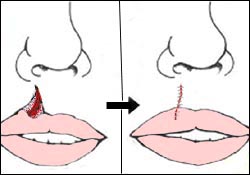
▴ 그림 1-14. 봉합수술 치료를 받기 전 입술 열상(좌)과
봉합 수술치료를 받은 후 입술 열상(우).
Copyright ⓒ 2011 John Sangwon Lee, MD., FAAP
열상의 원인
-
칼, 면도칼, 유리조각, 그 외 다른 종류의 예리한 물체로 전 피부층, 피하조직, 근육, 혈관, 말초 신경 등의 일부가 찢어지거나 베어져서 생긴 상처를 절상, 찢어진 상처, 열상(裂傷), 찢긴 상처, 또는 열창이라고 한다.
-
열상은 피부층 및, 또는 피하 조직에도 생길 수 있고.
-
열상이 뇌, 간 등 신체의 여러 계통 중 어느 계통의 한 개의 기관이나 여러 기관의 일부의 조직에 생길 수 있다.
-
열상은 외부에 가장 많이 노출된 얼굴, 팔다리, 또는 손발 등의 신체부위에 더 잘 더 잘 생길 수 있다.
-
열상은 교통사고나 안전사고 등으로 생길 수도 있고
-
열상만 따로 생길 수 있고, 타박상, 찰과상 또는 자상 등과 동시 생길 수도 있다.
-
전 피부층과 피하 조직에 열상이 생겼을 때는 육안으로 쉽게 볼 수 있기 때문에 열상이 있는 것을 쉽게 진단할 수 있다.
-
간장, 신장, 비장, 또는 뇌 등 신체 내 기관에 생긴 열상은 수술하지 않고 육안으로 볼 수 없기 때문에 신체 내 기관에 열상이 생겨 있는지 없는지 싑게 진단하기가 어렵다. [부모도 반의사가 되어야 한다–소아가정간호백과]-제2권 소아청소년 질병 안전사고 예방–일반적 예방, 제21권 소아청소년 가정간호–베타다인액 살균제, 피부용 과산화 수소액 살균제, 일회용 반창고 참고.
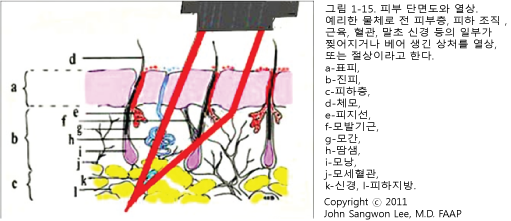
열상의 증상 징후
-
열상의 중증도, 원인, 열상이 생긴 신체부위에 따라 증상 징후, 진단, 치료가 다르다.
-
열상을 심하게 크기 입으면 열상 상처에 있는 혈관, 근육, 말초신경 등이 절단될 수 있고 절단된 정도에 따라 열상의 증상 징후가 다르게 나타난다.
-
심한 열상이 신체 깊숙이 있는 기관에 생겼을 때는 크고 작은 혈관, 신경 등도 절단되고 내출혈이 생기고 신경 마비도 생길 수 있다. 때로는 내출혈과 외출혈이 동시 심하게 생길 수 있다.
-
내외 출혈이 심하게 많이 생기면 쇼크에 빠질 수 있고 사망 한다.
-
열상으로 인한 말초 신경이 절단되면 열상이 생긴 신체 부위의 말단의 신경이 마비될 수 있다.
-
열상 상처가 붓고 아픈 것이 보통이다.
-
기관이나 조직에 큰 열상 상처가 생기면 그 기관이나 조직의 기능 장애가 생길 수 있다.
-
거의 모든 경우, 열상을 입은 상처를 적절히 잘 치료하지 않으면 열상 상처가 쉽게 곪는다.
-
불결한 열상, 오물이 묻은 열상, 이물이 들어 있는 열상, 적절히 치료하지 않은 열상에 세균이 쉽게 감염되어 열상 상처가 쉽게 곪아 감염병이 생길 수 있고 그에 따라 증상 징후가 생길 수 있다.
-
특히 얼굴, 입술, 손, 외부 생식기, 입, 안와 주위에 생긴 열상은 치료 받은 후에도 열상 받았던 신체 부위 기능 장애가 생길 수 있고 미관상 문제가 생길 수 있다.
-
그런 부위에 생긴 열상의 치료에 관해 더 잘 아는 전문의의 치료를 받을 필요가 있다.
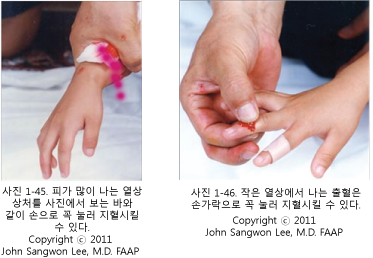
열상 치료
-
열상이 생긴 얼굴, 입술, 입안, 코, 귀, 두피, 목 등 신체 부위에 따라 열상의 증상 징후가 다르고 치료도 다르다.
-
열상으로 생긴 부위의 기능 장애에 따라 열상의 증상 징후가 다르고 치료 방법도 다르다.
-
피부층과 피하 조직에 생긴 열상의 치료에 관해 주로 다음 설명한다.
-
열상의 크기,
-
영상을 입은 후 얼마나 시간이 지났는지.
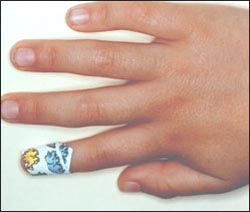
▴ 사진 60. 작고 깊지 않고 심하지 않은 열상은
베타다인액 살균제로 살균시킨 후 일회용
밴드로 덮어 치료할 수 있다.
Copyright ⓒ 2011 John Sangwon Lee, MD., FAAP
-
열상 상처로 생긴 합병증에 따라 치료 방법이 다르고 열상을 일률적으로 치료할 수 없다.
-
열상을 입고 당황하는 환아를 안정시킨다.
-
열상 상처에서 나는 출혈은 손가락, 손, 손가락, 지혈대, 또는 띠 등으로 지혈시킨다.
-
필요에 따라 주위 사람들의 도움을 청한다.
-
의료구급대, 병원 응급실, 또는 단골 소아청소년과의 지시에 따라 사고 현장에서 1차 응급치료를 시작한다.
-
입은 옷을 뚫고 신체 속 깊이 생긴 열상 1차 응급치료를 할 때는 옷을 조심히 벗기든지, 칼이나 가위로 옷을 잘라 벗긴 후 열상을 조심히 살펴보고 응급치료를 한다.
-
열상 상처의 표면에 묻어 있는 이물은 조심스럽게 제거해도 된다.
-
열상 상처 속 깊숙이 들어 가 있는 오물이나 물체는 가능 하면, 병원에서 의사가 빼낸다.
-
의사의 지시에 따라 아빠 엄마가 사고 현장에서 열상 상처에 박혀 있는 물체나 오물도 빼낼 수 있다.
-
열상 상처에서 조금 나는 출혈은 손가락 끝으로 열상 상처를 직접 눌러 지혈시킨다.
-
아주 심하게 나는 큰 열상 출혈은 열상 상처를 손바닥으로 눌러 지혈시키던지, 지혈대로 지혈시키든지, 열상 상처에 피를 공급하는 동맥이 있는 신체 부위를 손으로 꾹 눌러 지혈시킬 수 있다.
-
열상을 입은 신체 부위를 다른 신체 부위보다 좀 더 높게 올려 지혈시킬 수 있다.
-
불결한 칼이나 유리조각 등으로 베인 작은 열상은 살균 비누 물로 깨끗이 씻거나, 베타다인액 살균제로 씻을 살균 치료를 한다.
-
열상의 크기와 정도에 따라 일회용 밴드에이드나 델마본드(Dermabond)로 열상 상처를 덮어 치료하든지, 무균 거즈로 열상 상처를 덮고 그 거즈를 붕대로 감든지 또는 덮은 무균 거즈를 반창고로 감아 치료한다.
-
피부층의 표면에 생긴 작은 열상은 깨끗한 물로 깨끗이 씻고 지혈시킨다.
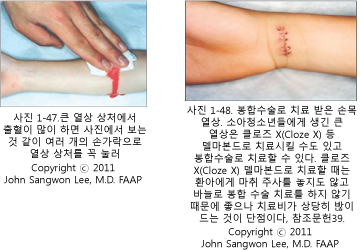
-
열상 상처에 항생제 연고를 바르고 그 위를 1회용 밴드 에이드로 덮어 응급 치료를 할 수 있다.
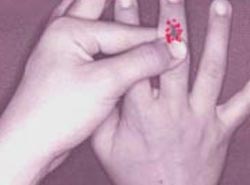
▴ 사진 1-49 작은 절상에서 나는 출혈은 손가락으로
눌러 지혈 시킬 수 있다.
Copyright ⓒ 2011 John Sangwon Lee, MD., FAAP
-
열상 상처가 크거나 깊거나 열상 입은 피부층 상처 가장자리가 많이 벌어졌으면 봉합수술 치료가 필요하다. 이런 저런 이유 때문에 열상이 생겼을 때, 대부분의 경우, 병원에서나 의사의 전화 지시에 따라 치료 받는 것이 가장 이상적이다.
-
일반적으로 열상의 길이가 3mm 이하이고 단순하게 찢어졌고 절상 상처가 깨끗하고 팔다리나 손, 발, 머리, 몸통 등의 신체 부위에 생긴 열상 상처는 부모가 집에서 비눗물로 깨끗이 씻고, 베타다인액 살균제로 살균 치료를 하든지, 또는 물로 씻지 않고 베타다인액 살균제로만 살균시키고 일회용 밴드에이드로 열상 상처를 덮어 치료해도 된다.
-
절상이 신체 어는 부위에 생겨 있느냐에 따라, 합병증의 유무에 따라 , 절상 치료방법이 다르지만, 적절히 치료한 피부 절상 상처는 대개 4~5일 정도 지나면 자연히 잘 낫는다.
-
좀 더 크고 피가 계속 나고 잘 치료되지 않은 절상은 치료 받은 후 흉터가 더 크게 생길 가능성이 많고 장차 미관상 문제도 생길 수 있다. 특히 얼굴이나 손 등에 생긴 큰 절상은 봉합수술 치료를 받아야한다.
-
절상이 생긴 신체 부위나 환아의 나이 등에 따라 절상의 치료 방법이 다르지만, 일반적으로 길이가 3mm보다 더 큰 절상은 봉합수술 치료를 받는다. 3mm보다 더 큰 두피 절상은 봉합수술 치료를 받지 않아도 잘 낫는 것이 보통이다.
-
팔다리에 생긴 절상은 봉합수술 치료를 받은 후 6~8일, 얼굴이나 두피에 생긴 절상은 봉합수술 치료를 받은 후 5일이 되었을 때 봉합수술 실밥을 빼주는 것이 보통이다.
-
봉합수술로 치료 받지 않은 절상이나 봉합수술로 치로 받은 절상이 때로는 곪을 수 있다. 절상이 곪으면 절상 상처가 붓고, 붉고, 아프고, 피고름이 날 수 있다.
-
절상이 곪을 때는 곪은 정도에 따라 적절한 항생제로 치료 받는다.
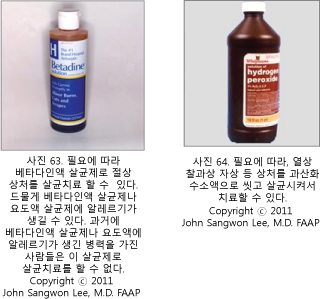
- 요즘, 단순 절상을 봉합수술로 치료하는 대신 국소 피부 접착제(예: Cyanoacry topical skin adhesives)나, 델마본드, 외과용 테이프로 절상을 치료하기도 한다.
-
이런 식으로 치료하면 봉합수술 치료를 받을 때보다 아프지도 않고 짧은 시간 내 더 쉽게 치료 받을 수 있고 붙였던 접착제를 뗄 필요도 없다(출처; NEJM Sep 2008 p.1037).
-
절상을 입었을 때 필요에 따라 파상풍 백신으로 파상풍 예방접종을 받아야 한다.
-
절상 상처 부위가 불결할 때는 세균에 감염되어 곪지 않도록 항생제로 예방적 치료를 받을 수 있다.
열상의 치료를 요약하면,
-
열상이 신체의 어느 부위에 생겼는지,
-
열상 상처가 얼마나 불결한지,
-
열상에 이물이나 오물이 있는지,
-
장차 미관상 문제 등을 고려해서
-
집에서 부모가 1 차 응급 치료를 할 것인지,
-
병원 응급실에서나 단골 소아청소년과, 또는 동네 외과의원에서 봉합 수술치료를 받을 것인지, 또는 델마본드 등으로 치료받을 것인지를 결정한다.
|
다음은 “얼굴에 난 열상, 상흔, 상처치료법 좀 알려 주세요.”에 관한 인터넷 소아청소년 건강상담 질의응답의 예 입니다. |
Q&A. 얼굴에 난 열상, 상흔, 상처 치료법 좀 알려 주세요.
Q.
오늘 낮에 6살 난 딸아이 눈 밑으로 5cm정도 연필로 그어져 피가 나왔습니다.
일단은 ‘후시딘‘을 바르고 흉터가 남을까봐 너무 맘 아프고 걱정이 되서 주위에 물어보니 상처 안 남는 약이 있다구 하더군요. 그래서 약국에 데리고 가 물어보니 상처가 그리 깊지는 안다며 ‘밍크오일‘ 이라는 걸 권하시더라구요. 화장품 샘플병만 한데 8천원이라구… 효과 있다구 하시는데 일단은 써 보자싶어 사가지고 와서 약국에서 이르는 데로 상처에 물 안 닿게 하고 바르고 있습니다. 그런데 솔직히 안심은 안 되고 혹시 쓸데없는 짓 한거 아닌가… 상처 덧나는 거 아닌가 싶기도 하고 해서 여쭈어 보려고요.
가장 효과적인 방법을 좀 알려주세요.
A.
주희님
안녕하세요. 좋은 질문해 주셔서 감사합니다. 자녀의 나이, 성별, 과거 병력, 가족 병력, 진찰소견, 임상검사 등의 정보를 많이 알수록 답변을 드리는데 도움이 더 많이 됩니다. 주신 정보를 토대로 해서 답변을 드리겠습니다.
열상을 입은 후 흉터가 생기지 않게 치료할 수 있는 특효약도 특별한 방법도 없습니다. 그러나 열상의 정도가 아주 작고 깊지 않을 때는 흉터가 아주 적게 생기든지 또는 거의 생기지 않을 수 있습니다.
열상의 깊이와 크기, 열상 입은 신체 부위, 열상 입은 상처 부위에 생긴 염증의 유무, 열상 입은 후 치료 방법, 인종, 개인 체질 등에 따라 흉터의 크기와 상태가 다르게 나타날 수 있습니다.
다음 정보를 참조하시기 바랍니다.
걱정이 되시면 소아청소년과에서 진찰 진단을 받으시고 이 문제에 관해서 상담하시기 바랍니다.
[부모도 반의사가 되어야 한다–소아가정간호 백과]-P 열상, P찰과상 등을 참조하시기 바랍니다. 질문이 더 있으시면 다시 연락 주시기 바랍니다.
감사합니다. 이상원 드림
다음 같이 열상을 치료하면 열상 상처가 잘 낫고 흉터가 적게 생길 수 있습니다
-
“열상을 입은 피부층 가장자리가 서로 벌려져 있고 열상의 길이가 1~1.2cm 이상 되고, 얼굴에 생긴 열상의 길이가 0.6mm 이상 되면 봉합수술 치료를 해 주는 것이 이상적이다.
-
열상을 입은 후 적어도 4~12시간 이내에 봉합수술 치료를 받아야한다.
-
필요에 따라 열상을 입은 후 곧 비눗물로 깨끗이 씻고,
-
열상에 묻은 오물을 제거하고,
-
항생제 연고를 바르거나 살균제로 살균시킨다.
-
세균이나 오물이 열상에 묻지 않게 하고,
-
멸균 일회용 밴드에이드나 무균 거즈로 열상을 덥고,
-
열상이 곪지 않게 주의하면서 치료하고,
-
곪으면 곧 적절히 치료하면 흉터가 덜 생긴다.
-
열상의 크기와 깊이, 열상 입은 신체 부위 등에 따라 봉합수술 치료를 하고 봉 합수술 실을 적기에 빼고 딱지가 있으면 뗀다.
-
열상이 치료된 후 열상 입은 부위에 외상을 또 입지 않도록 예방한다.
-
파상풍 백신으로 예방접종을 필요에 따라 받는다.
-
열상으로 생긴 경미한 상흔이 완전히 보이지 않게 낫는 데는 6~12개월이 걸리는 것이 보통이다“.
|
다음은 “열상, 찰과상, 자상, 곪은 상처.”에 관한 인터넷 소아청소년 건강상담 질의응답의 예 입니다. |
Q&A. 열상, 찰과상, 자상, 곪은 상처에 관해 말씀해주세요.
Q.
아이가 부엌칼을 손으로 만져 0.8mm 비었는데 처음엔 병원에 가지 않고 마데카솔만 발라주었습니다. 이번 주 초에 그랬는데 오늘 아침에 곪아서 병원에 가 치료를 받으려고 하니까 의사선생님이 아직 많이 곪지 않아 지금은 할 수 없다며 아이들은 골수염에 걸리기 쉬우므로 현재 엄지 안쪽이 곪은 게 바깥쪽까지 퍼지면 종합병원에 입원한다고 말씀하셔서 너무 놀라 문의합니다.
23개월인 남자아이인데 칼로 손가락을 약간 베어도 그런 무서운 병에 걸리나요. 엄마가 제대로 봐주지 않아서 다친 것 같아 너무 맘이 아프고 속상합니다. 아이는 잘 놀고 장난감도 잘 만지거든요.
2~3일 경과 봐서 병원에 가야한다는데 그 시간이 너무 깁니다.
A.
현민맘께
안녕하세요. 좋은 질문해 주셔서 감사합니다.
자녀의 나이, 성별, 과거 병력, 가족 병력, 진찰소견, 임상검사 등의 정보를 많이 알수록 답변을 드리는데 더 도움 됩니다. 주신 정보를 토대로 해서 답변을 드리겠습니다.
박테리아가 열상(절상) 상처나 절상 상처에 감염되면 그 상처가 곪을 수 있습니다.
절상 상처 감염을 일으킨 박테리아가 상처 주위에 있는 피하 조직 , 혈액, 관절, 뼈, 뇌막 등으로 전파될 수 있습니다.
뼈 속 골수에 감염되면 골수염이 생길 수 있고,
관절에 감염되어 관절염이 생길 수 있고, 혈액 속으로 감염되어 패혈증이 생길 수 있고 뇌막으로 감염되어 뇌막염이 생길 수 있습니다.
절상 상처에 생겼던 하찮은 상처 감염병에서 박테리아가 전신으로 퍼져 생명을 위협할 수 있는 감염병을 일으킬 있다는 것을 알면 작은 절상이나 자상 때문에 걱정을 많이 하시는 부모들도 있을 것입니다.
이런 외상을 입는 일이 자주 생기지는 않지만 이런 종류의 감염병으로 고생도 많이 할 수 있고 때로는 귀중한 재산과 생명을 잃기도 합니다.
주신 정보를 토대로 답변을 드리면, 아마도 골수염은 생기지 않은 것 같지만 가능성은 배제할 수 없습니다.
절상 상처가 곪았으면 빨리 치료할수록 치료효과는 더 좋습니다. 기다리시지 말고 빨리 적절히 치료해 주시기 바랍니다.
찰과상, 열상, 자상, 파상풍 예방접종 등을 참조하시기 바랍니다.
질문이 더 있으면 다시 연락해 주시기 바랍니다. 감사합니다. 이상원 드림
Lacerations (Tear/Tear/Rise/Fire)
Overview of lacerations
In most cases, prior to the first emergency treatment by a doctor for injuries such as burns, cuts, lacerations, etc. that occurred to children and adolescents, take first-stage emergency treatment at the site of the accident in which the were injured, such as burns, cuts, lacerations, etc.
It is common to have priority first.
Then, catch-up (tracking) treatment is carried out by parents at home according to the doctor’s telephone treatment instructions, parents do catch-up treatment on their own without the help of a doctor, or go to the Pediatrics Department to receive catch-up treatment or emergency medical treatment.
It is common to go to and get catch-up treatment there.
Here, we will explain how to manage acute cutaneous wounds (Acute cutaneous wounds management) at the first stage that can provide emergency treatment at the site of an accident in which children and adolescents have injured injuries.

▴ Figure 1-14. Lip laceration (left) and before receiving suture surgery Lip laceration after suture surgery treatment (right). Copyright ⓒ 2011 John Sangwon Lee, MD., FAAP
Laceration causes
A knife, a razor, a piece of glass, or other types of sharp objects cuts the entire skin layer, subcutaneous tissue, muscles, blood vessels, peripheral nerves, etc. It is called a laceration.
Lacerations can also occur in the skin layer and, or subcutaneous tissue.
Lacerations can occur in one organ of any of the various systems of the body, such as the brain and liver, or in some tissues of several organs.
Lacerations are more likely to occur on body parts such as the face, limbs, or limbs that are most exposed to the outside.
Laceration can be caused by traffic accidents or safety accidents, etc.
Only lacerations may occur separately and may occur simultaneously with bruises, abrasions, or cuts.
When lacerations occur on the entire skin layer and subcutaneous tissue, they can be easily seen with the naked eye, so it is easy to diagnose that there is a laceration.
Since lacerations in internal organs such as the liver, kidney, spleen, or brain cannot be seen with the naked eye without surgery, it is difficult to quickly diagnose whether lacerations have occurred in the internal organs of the body.
[Parents should also be at least the half-doctors-Encyclopedia of Child and Family Nursing]-Volume 2 Prevention of Child and Adolescent Disease Safety Accidents-General Prevention, Volume 21 Child and Adolescent Home Nursing-Betadine solution disinfectant, skin hydrogen peroxide disinfectant, disposable band-aid.Symptoms sign of laceration

Symptoms, diagnosis, and treatment differ depending on the severity, cause, and part of the body where the laceration occurred.
If the laceration is severely sized, the blood vessels, muscles, and peripheral nerves in the laceration wound may be amputated, and symptoms of laceration may differ depending on the extent of the cut.
When a severe laceration occurs in an organ deep in the body, large and small blood vessels, nerves, etc. may also be cut, internal bleeding may occur, and nerve paralysis may occur.
Sometimes, both internal and external bleeding can occur simultaneously.
Severe internal and external bleeding can lead to shock and death.
If the peripheral nerve is cut due to the laceration, the nerve at the end of the body part where the laceration has occurred can be paralyzed.
The laceration wound is usually swollen and painful.
Large lacerations in organs or tissues can cause dysfunction of the organs or tissues.
In almost all cases, laceration wounds fester easily if they are not properly treated.
Infectious diseases may occur due to the festering of the laceration wound easily due to bacteria easily infected by the bacteria on the lacerations that are dirty, lacerations with dirt, lacerations containing foreign matter, lacerations that have not been properly treated, and symptomatic symptoms may occur accordingly.
In particular, lacerations around the face, lips, hands, external genital organs, mouth, and orbits may cause dysfunction of the body part that received the laceration even after treatment and may cause cosmetic problems.
You need to see a specialist who knows better about the treatment of lacerations in those areas.
Laceration treatment
The symptoms of lacerations differ depending on the part of the body, such as the face, lips, mouth, nose, ears, scalp, and neck where the laceration has occurred, and the treatment is different.
Depending on the dysfunction of the area caused by the laceration, the symptoms of lacerations differ and treatment methods are different.
The following mainly describes the treatment of lacerations in the skin layer and subcutaneous tissue.
Laceration size,
How long has passed since the laceration?

▴ Photo 60. Small, not deep, and not severe lacerations
Disinfection after sterilization with betadine solution disinfectant
It can be treated by covering it with a band.
Copyright ⓒ 2011 John Sangwon Lee, MD., FAAP

The treatment method differs depending on the complications caused by laceration wounds, and lacerations cannot be treated uniformly.
It stabilizes the child who suffers from lacerations and is embarrassed.
Bleeding from a laceration wound is stopped with pressure by a finger, hand, finger, tourniquet, or band.
Ask for help from people around you as needed.
Start the first emergency treatment at the accident site according to the instructions of a medical paramedic, hospital emergency room, or regular pediatrics and adolescents department.
When performing the first emergency treatment for lacerations that have penetrated through the clothes you wear, take off your clothes carefully, or cut off your clothes with a knife or scissors, and then carefully examine the lacerations and provide emergency treatment.
You can carefully remove any foreign matter from the surface of the laceration wound.
If possible, a doctor will remove any dirt or objects that are deep inside the laceration wound.
According to the doctor’s instructions, the father and mother can also remove objects or dirt from the laceration wound at the scene of the accident.
The bleeding from the laceration wound is stopped by pressing the laceration wound directly with the tip of the finger.
Large laceration bleeding that occurs very severely can be stopped by pressing the laceration wound with the palm of the hand, stopping the bleeding with a tourniquet, or by pressing firmly on the part of the body where the artery supplies blood to the laceration wound is held.
You can stop the bleeding by raising the affected body part higher than other parts of the body.
Small lacerations cut with dirty knives or pieces of glass, etc., should be washed thoroughly with sterilizing soap water, or sterilized by washing with betadine solution disinfectant.
Depending on the size and extent of the laceration, treat the laceration by covering the laceration with a disposable band-aid or Dermabond, cover the laceration with sterile gauze and wrap the gauze with a bandage, or wrap the covered sterile gauze with a band-aid for treatment.
Small lacerations on the surface of the skin layer are washed with clean water and bleeding.
You can apply antibiotic ointment to the laceration wound and cover it with a disposable band-aid for emergency treatment.


▴ Photo 1-49 Bleeding from small incisions
You can stop bleeding by pressing.
Copyright ⓒ 2011 John Sangwon Lee, MD., FAAP
If the laceration wound is large or deep, or the wound edge of the laceration skin layer is wide open, suture surgery is required.
When lacerations occur for these or other reasons, in most cases, it is most ideal to receive treatment at a hospital or according to the doctor’s telephone instructions.
In general, lacerations with a length of less than 3mm, simple torn, clean cuts, and lacerations on body parts such as limbs, hands, feet, head, and torso are cleaned by parents at home with soapy water and used as a betadine disinfectant.
Either sterilization treatment may be performed, or sterilization may be performed with only betadine solution disinfectant without washing with water, and the laceration wound may be covered with a disposable band-aid for treatment.
Depending on where the cut occurs in the body, depending on the presence or absence of complications, the treatment method for cuts is different, but appropriately treated cutaneous cuts usually heal naturally after about 4 to 5 days. Larger, bleeding and poorly treated wounds are more likely to cause larger scars after treatment and may lead to cosmetic problems in the future.
In particular, large incisions on the face or hand should be treated with suture surgery.
Although the treatment method for resections differs depending on the part of the body where the resection occurs or the child’s age, etc., in general, incisions larger than 3mm in length are treated with suture surgery.
It is common for scalp incisions larger than 3mm to heal well even without suture surgery.
It is common to remove the stitches for incisions in the limbs 6 to 8 days after receiving suture surgery, and 5 days after receiving suture surgery for incisions on the face or scalp.
Incisions that have not been treated with suture surgery or incisions received with suture surgery can sometimes fester.
If the cut is festered, the cut may become swollen, red, painful, and blood pus may appear.
When the wound is festered, it is treated with appropriate antibiotics depending on the degree of festering.
Nowadays, instead of treating simple incisions with suture surgery, local skin adhesives (eg, Cyanoacry topical skin adhesives), Delmar Bond, and surgical tapes are used to treat incisions.
Treatment in this way makes it easier to treat in a short period of time and does not hurt more than when undergoing suture surgery (source; NEJM Sep 2008 p.1037).
If you are wounded, you should be vaccinated against tetanus with a tetanus vaccine as needed.
When the cut wound is dirty, you can receive prophylactic treatment with antibiotics to prevent festering due to bacterial infection.
To summarize the treatment of lacerations,
Where the laceration occurred on the body, How dirty the laceration is, Whether there is a foreign matter or dirt on the lacerations, In consideration of future aesthetic issues, etc.
Whether the parents will perform the first emergency treatment at home, Decide whether to receive suture surgery treatment at the hospital emergency room, regular pediatrics department, or local surgeon, or treatment with
Delma Bond
.
The following is an example of the online pediatric and adolescent health counseling question and answer on
“Please tell me how to treat lacerations, scars, and wounds on my face.”
Q & A.
Please tell me how to treat lacerations, scars, and wounds on the face.
Q.
Today, my 6-year-old daughter was drawn with a 5cm pencil under her eyes and her blood came out.
First of all, I applied’ Fushidin’ and I was so sick and worried that her scar would remain, so I asked her around and said that there is a medicine that does not leave scars.
So she took it to the pharmacy and asked, “I know the wound is very deep,” and she recommended that it is “mink oil”. Only a cosmetic sample bottle costs 8,000 won…
They say it’s effective, but I want to try it first.
출처 및 참조 문헌
-
Childhood Emergencies in the Office, Hospital and Community, American Academy of Pediatrics
-
Emergency Medical Service for Children, By Ross Lab. May 1989. p.10
-
Emergency care, Harvey grant, and Robert Murray
-
Emergency Care Transportation of Sick and Injured American Academy of Orthopaedic Surgeons
-
Emergency Pediatrics A Guide to Ambulatory Care, Roger M. Barkin, Peter Rosen
-
Immediate care of the acutely ill and injured, Hugh E. Stephenson, Jr
-
The Critically Ill Child, Diagnosis and Management, Edited by Clement A. Smith
-
Emergency Medical Services for Children: The Role of the Primary Care Provider, America Academy of Pediatrics
-
Quick Reference To Pediatric Emergencies, Delmer J. Pascoe, M.D., Moses Grossman, M.D. with 26 contributors
-
Manual of Emergency Care 응급환자관리 정담미디어
-
소아가정간호백과–부모도 반의사가 되어야 한다, 이상원
-
Neonatal Resuscitation American heart Association
-
Neonatology Jeffrey J.Pomerance, C. Joan Richardson
-
Pediatric Resuscitation Pediatric Clinics of North America, Stephen M. Schexnayder, M.D.
-
Pediatric Critical Care, Pediatric Clinics of North America, James P. Orlowski, M.D.
-
Preparation for Birth. Beverly Savage and Dianna Smith
-
Nelson Textbook of Pediatrics 14th ed. Beherman,
-
The Johns Hopkins Hospital, The Harriet Lane Handbook, 18th edition
-
Red book 29th-31st edition 2012
-
Nelson Text Book of Pediatrics 19th-21st Edition
-
Infectious disease of children, Saul Krugman, Samuel L Katz, Ann A. Gershon, Catherine Wilfert
-
The Harriet Lane Handbook 19th Edition
-
소아과학 대한교과서
-
제1권 소아청소년 응급의료 참조문헌과 출처
-
Other
Copyright ⓒ 2015 John Sangwon Lee, MD., FAAP
“부모도 반의사가 되어야 한다”-내용은 여러분들의 의사로부터 얻은 정보와 진료를 대신할 수 없습니다.
“The information contained in this publication should not be used as a substitute for the medical care and advice of your doctor. There may be variations in treatment that your doctor may recommend based on individual facts and circumstances. “Parental education is the best medicine.”